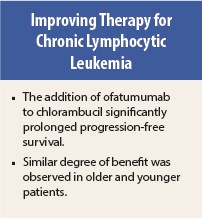In the phase III COMPLEMENT 1 trial reported in The Lancet, Peter Hillmen, MB, ChB, of St. James’s University Hospital, Leeds, and colleagues found that the addition of the anti-CD20 antibody ofatumumab (Arzerra) to chlorambucil (Leukeran) increased progression-free survival among patients with chronic lymphocytic leukemia (CLL) who were not considered candidates for fludarabine due to older age or comorbidities.1
Study Details
In this open-label trial, 447 patients from 16 countries were randomly assigned between December 2008 and May 2011 to receive chlorambucil at 10 mg/m2 on days 1 to 7 with (n = 221) or without (n = 226) ofatumumab every 28 days for 3 to 12 cycles. Ofatumumab was given at 300 mg on day 1 and 1,000 mg on day 8 of cycle 1, followed by 1,000 mg on day 1 of subsequent cycles.
Patients could not be considered candidates for fludarabine-based treatment. The primary endpoint was progression-free survival on independent review in the intention-to-treat population.
The combination and chlorambucil groups were generally balanced for age (median, 69 and 70 years, 69% in both ≥ 65 years), sex (64% and 62% men), Binet stage (A in 35% and 31%, B in 33% and 38%, C in 32% and 31%), Eastern Cooperative Oncology Group performance status (0 for 39% and 38%, 1 for 53% and 54%), B symptoms (53% in both), and all other baseline characteristics.
Progression-Free Survival
Both groups received a median of six treatment cycles. Median follow-up was 28.9 months. Median progression-free survival was 22.4 months (95% confidence interval [CI] = 19.0–25.2 months) in the chlorambucil/ofatumumab group vs 13.1 months (95% CI = 10.6–13.8 months) in the chlorambucil group (hazard ratio [HR] = 0.57, P < .0001).
Hazard ratios favored combination treatment in all subgroups. Combination treatment was associated with consistent benefit in patients aged < 65 years (HR = 0.54, 95% CI = 0.34–0.85), ≥ 65 years (HR = 0.57, 95% CI = 0.43–0.76), and ≥ 75 years (HR = 0.56, 95% CI = 0.35–0.89).
Time to Next Therapy
The combination group had significantly prolonged time to next therapy (median, 39.8 vs 24.7 months, HR = 0.49, P < .0001). After a median of 6 months of treatment in both groups, the median treatment-free period was 34 vs 19 months. Salvage therapy was used in 29% vs 44% of patients, with the most common treatment being rituximab (Rituxan) alone or in combination (17% and 31%).
Objective response rates were 82% vs 69% (odds ratio = 2.16, P = .001), with complete response in 14% vs 1%. No difference in overall survival was observed at the time of analysis, with death occurring in 15% of the combination group and 18% of the chlorambucil group (HR = 0.91, P = .666). Two-year survival was 89% vs 87% and 3-year survival was 85% vs 83%.
Adverse Events
Adverse events ≥ grade 3 occurred in 50% of the combination group and 43% of the chlorambucil group, including 59% and 51% of patients aged ≥ 65 years.
Among grade ≥ 3 adverse events, neutropenia occurred in 26% vs 14% (30% vs 15% of patients aged ≥ 65 years), thrombocytopenia in 5% vs 10% (7% vs 10%), anemia in 5% vs 5% (5% vs 6%), and infection in 9% vs 12% (13% vs 15%). Grade ≥ 3 infusion-related reactions occurred in 10% of the combination group.
Adverse events led to discontinuation of study treatment in 13% of both groups and in 15% of patients aged ≥ 65 years in both groups. Death considered related to study treatment occurred during the treatment period in three patients in the chlorambucil-ofatumumab group and two in the chlorambucil group.
Study Implications
The investigators concluded: “Addition of ofatumumab to chlorambucil led to clinically important improvements with a manageable side-effect profile in treatment-naive patients with chronic lymphocytic leukaemia who were elderly or had comorbidities. Chlorambucil plus ofatumumab is therefore an important treatment option for these patients who cannot tolerate more intensive therapy.”
They noted: “More research is warranted to establish whether and how ofatumumab and obinutuzumab [Gazyva] differentiate from each other and from rituximab; to establish if one antibody is more suitable for a specific patient subgroup; and to explore which chlorambucil backbone regimen is the most complementary to anti-CD20 antibody therapy.” ■
Disclosure: The study was funded by GlaxoSmithKline and Genmab A/S. For full disclosures of the study authors, visit www.thelancet.com.
Reference
1. Hillmen P, Robak T, Janssens A, et al: Chlorambucil plus ofatumumab versus chlorambucil alone in previously untreated patients with chronic lymphocytic leukaemia (COMPLEMENT 1): A randomised, multicentre, open-label phase 3 trial. Lancet 385:1873-1883, 2015.



